The best dog food for diabetic dogs is typically high in fibre and low in simple carbohydrates. When a dog eats, the sugar from the food enters the bloodstream. Normally, insulin is produced to help move sugar into cells, fuelling muscles and vital organs. However, diabetic dogs cannot produce sufficient insulin on their own, leading to elevated blood sugar levels after meals. Like humans with diabetes, dogs require insulin injections to help move glucose from the bloodstream into the body's cells, where it is metabolised for energy.
There are some dog breeds that are more likely to develop diabetes than others. In addition, being overweight also increases the likelihood of developing diabetes. Pet Plan's veterinary expert, Brian Faulkner, describes in detail what signs to look for in a diabetic dog. Noticeable symptoms are thirst and hunger. Then, more severe signs, including dehydration, collapse and a diabetic coma. Badly controlled diabetes can affect the heart, kidneys, eyes, nerves, and blood vessels. If left untreated, diabetes can cause serious illness and even be fatal.
Best dog food for diabetic dogs at a glance
The good news is that with a consistent eating routine and proper treatment, diabetic dogs can lead a happy, healthy life. They require careful monitoring and a combination of a balanced diet, exercise and insulin. Consistency is key to managing the condition effectively. For example, you may find it beneficial to base your pet's diet around dry dog food as it can be precisely weighed, making it easier to provide consistent portions at each meal, which helps maintain stable blood sugar levels.
It’s important to monitor the amount of carbohydrates in dog food because carbohydrates break down into sugar, which is harmful to diabetic animals if not properly managed. In some cases, dog food for weight loss is suggested for diabetic dogs because it is high in protein, low in fat and calorie-controlled. However, primarily you should choose a food that is high in fibre and low in simple carbohydrates, not just focused on weight loss. Certain foods are better for diabetic dogs, so seek out advice from your vet.
Dietetic food should only be given with the guidance of a vet.
Best dog food for diabetic dogs
Best overall diabetic dog food
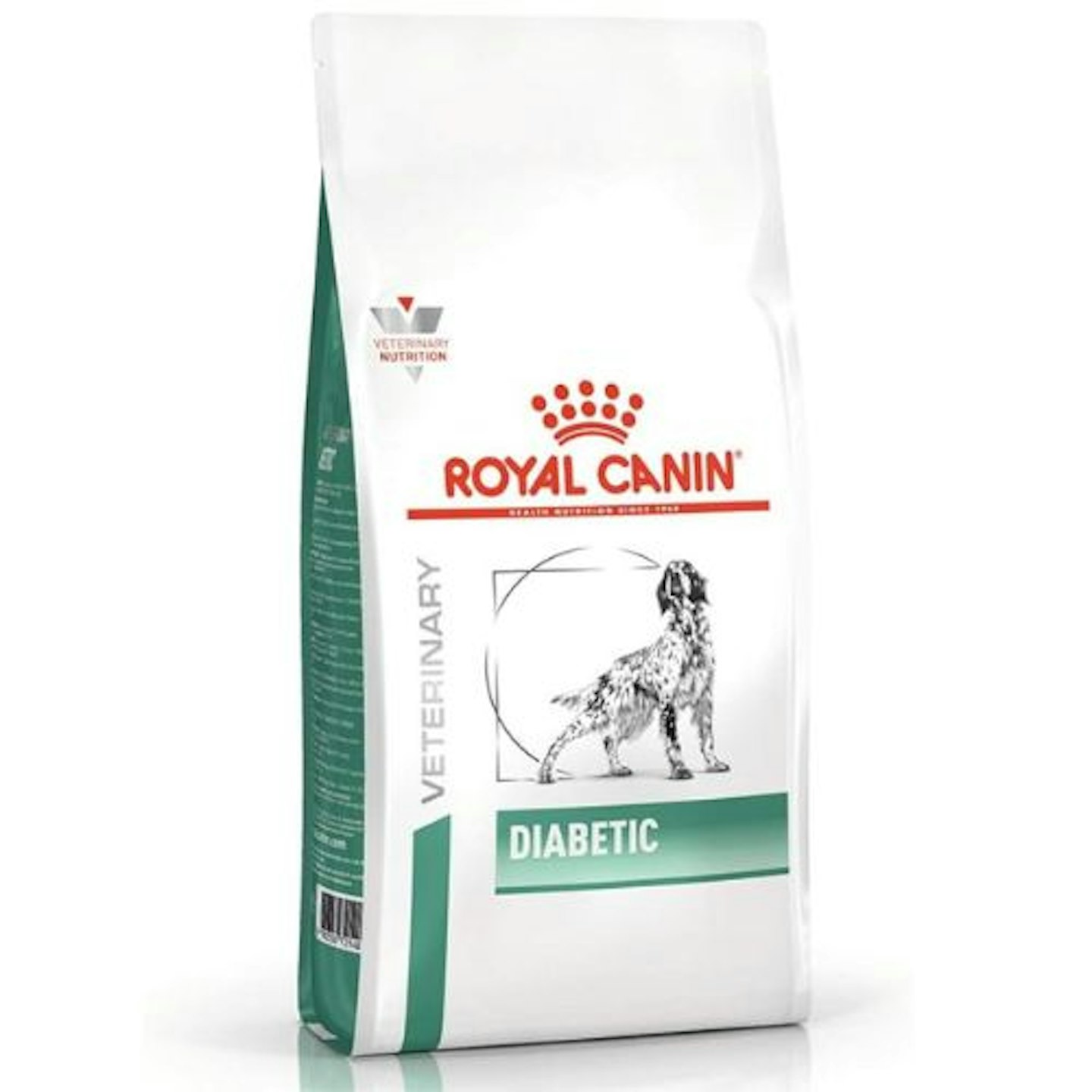 ROYAL CANIN
ROYAL CANINRoyal Canin Veterinary Diet Diabetic is a complete and balanced food with reduced carbohydrates and can help manage diabetic dogs' blood sugar levels. This food has a low glycaemic index, meaning it causes a slower rise in blood sugar after eating. It is a high-protein food that gives dogs energy and maintains muscle mass and a healthy weight. When a dog has its meal, the fibre contents help to manage blood sugar levels. Be aware that it contains wheat, so it will not be suitable for dogs with a gluten intolerance. A diabetic wet food option is also available, and Royal Canin recommends feeding both wet and dry food. This dietetic food should only be given under a vet’s guidance.
Reviews praise this dry dog food for stabilising their dogs' diabetes. A minority of comments say it fluctuates in price, so it pays to shop around to get the best deal.
Pros
- Effective at keeping a dog's blood sugar levels more stable during eating than normal kibble
- Dry dog food is easy to portion by weighing it
- A complete dietetic food that's effective in managing diabetes
Cons
- Contains wheat, therefore it's not suitable for dogs that have a gluten intolerance
| Ingredients: | Dehydrated poultry protein, barley, wheat gluten*, maize gluten, vegetable fibres, animal fats, tapioca, beet pulp, hydrolysed animal proteins, fish oil, psyllium husks and seeds, fructo-oligo-saccharides, minerals, marigold extract (source of lutein) |
Best diabetic dog food with dietary fibre
 PRO PLAN
PRO PLANSpecially formulated to be a complete, yet low-carb, dry food for diabetic dogs, this PRO PLAN VETERINARY DIETS DM Diabetes Management food helps reduce blood sugar spikes (hypoglycaemia) during eating. As well as containing fewer carbs, it contains an amylase inhibitor from white bean extract that reduces carbohydrates being converted into sugar during digestion. This kibble helps keep blood sugar levels stable and lessens big changes in blood sugar levels after meals. In addition, it contains antioxidants that help to protect cells from damage. It also includes ingredients (chondroitin and glucosamine) that support healthy joints.
Customer reviews indicate that the kibble is effective in keeping dogs' diabetes under control. However, it did not appeal to some dogs, and some customers commented that it was expensive.
Pros
- Designed to limit blood sugar spikes after eating
- Dietary fibre slows carbohydrate absorption and helps control blood sugar levels after a meal
- Complete dog food that supports overall health
Cons
- Try a small bag first, as it did not agree with some dogs
| Ingredients: | Dehydrated poultry protein, barley<em>, </em>maize gluten meal, maize, soya meal, pea fibre, animal fat, digest, dried beet pulp, fish oil, minerals, white bean extract |
Best diabetic dog food for steady energy release
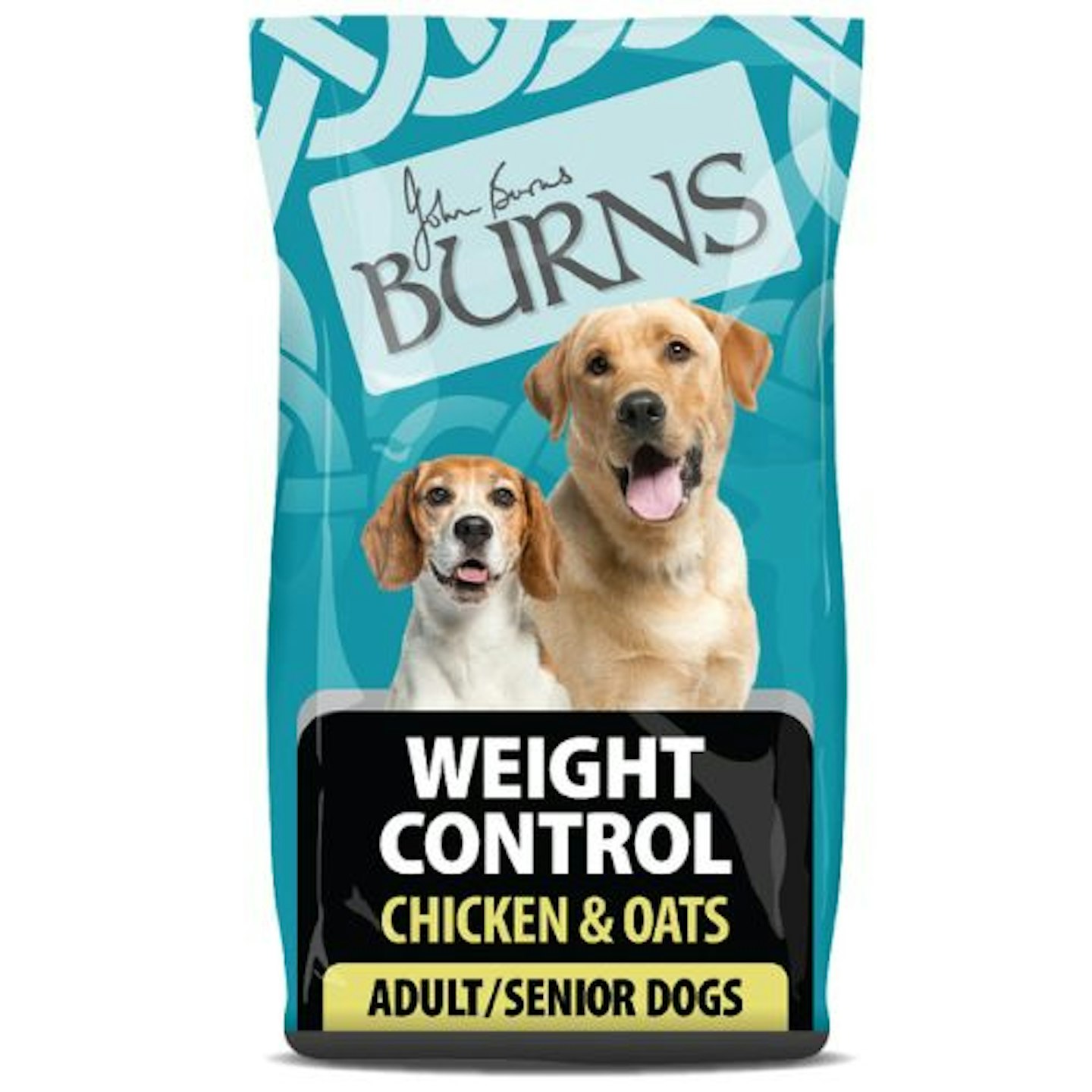 Burns
Burnsburnspet.co.uk
Laura Crotch-Harvey, Nutrition Manager, Burns Pet Nutrition, recommends that Burns Weight Control Chicken & Oats be a widely available option for dogs with diabetes. It has a low sugar content and is high in fibre from whole grain oats, providing a steady energy release. The food has been specially formulated to not contain any major food allergens, such as wheat and dairy. Each bite is 11mm, so it's a large kibble that will be satisfying for a dog to chew rather than wolf down.
Customer reviews mainly relate to this dog food being an enjoyable kibble that's satisfying, yet keeps a dog's weight under control. You should speak to a Burns' Nutritional Advisor before giving this kibble to a diabetic dog.
Pros
- Contains wholesome and recognisable ingredients
- Free from major food allergens
- Slow-release energy from whole grain oats will keep a dog full all day
Cons
- Seek the advice of a vet or pet nutritionist before feeding to a diabetic dog
| Ingredients: | Oats (55%), Brown Rice (18%), Chicken Meal (17%), Peas, Chicken Oil, Seaweed, Minerals |
Best dietetic dry dog food for weight management
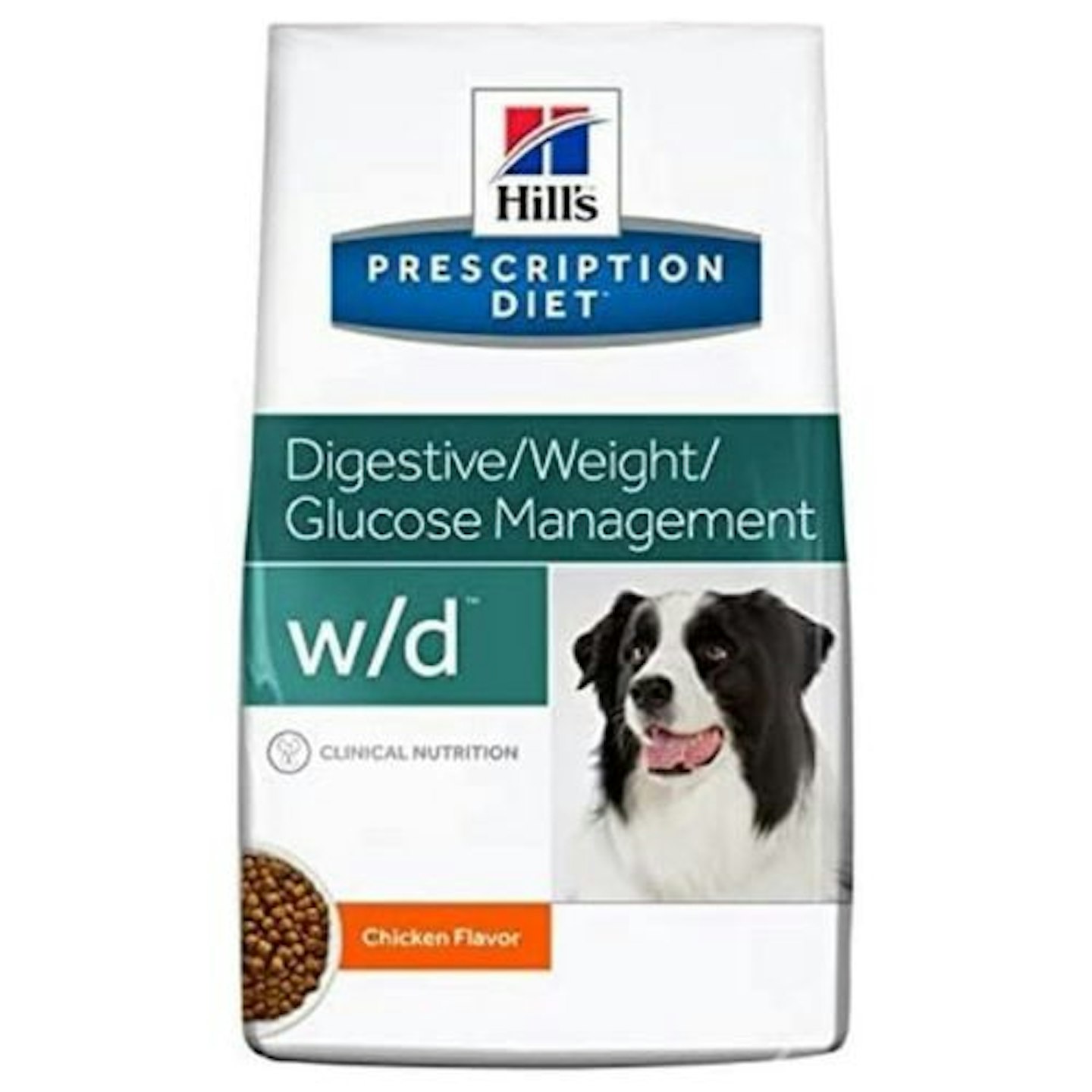 Hills
HillsHills Prescription Diet W/D Low Fat Dry Dog Food has been specially formulated by vets and pet nutritionists to manage diabetes in dogs. It's a low-sugar food and calorie-controlled kibble containing soluble and insoluble fibre to regulate blood sugar levels. Each bite is 12mm in diameter, which is larger than most dry dog food - therefore, it takes longer to chew. This clinically developed dietetic food contains high-quality protein to support muscle mass and L-carnitine, which helps the body convert fat into energy.
Online reviews suggest this kibble has been rebranded, so be aware that the packaging may differ. Overall, it's an effective and palatable food for dogs with diabetes and weight control from a leading brand.
Pros
- Large kibble slows down eating and cleans a dog's teeth
- Complete dietetic food for maintaining a healthy weight and managing diabetes
- Supplemented with Omega fatty acids to maintain overall health and vitality
Cons
- Reviews indicate confusion that the product has been rebranded or the recipe has changed
| Ingredients: | Wheat, maize, chicken- (9%) and turkey meal, cellulose, maize gluten meal, protein hydrolysate, pea bran meal, animal fats, dried beet pulp, barley, oats, soya bean oil, minerals, fish oil, L-carnitine, vitamins, trace elements, beta-carotene |
Best high fibre wet dog food
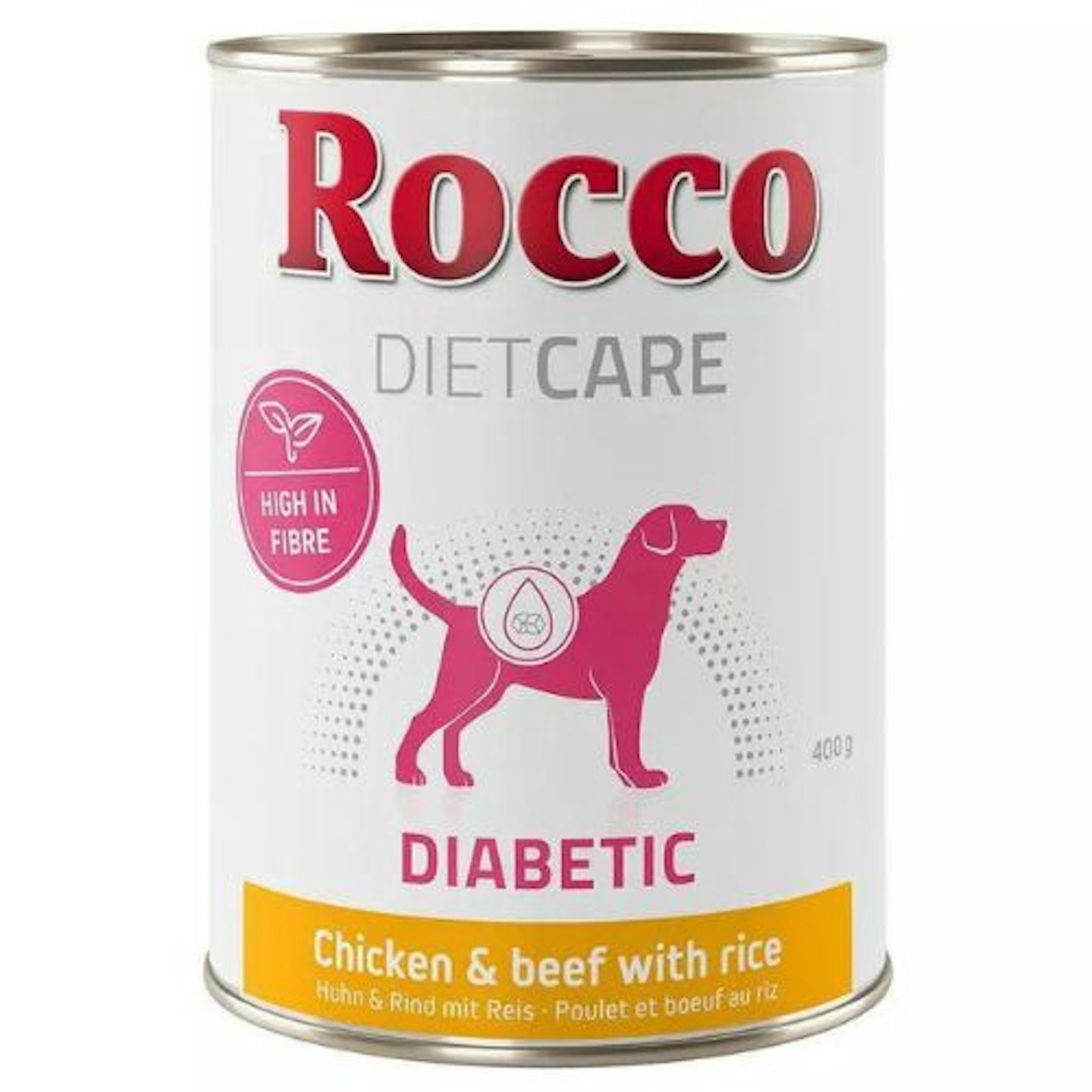 Rocco
Roccowww.ebay.co.uk
Rocco Diet Care Diabetic is a wet dog food with a low sugar (mono- and disaccharide) content. It's rich in fibre to minimise blood sugar fluctuations. The carbohydrate is rice, which is digestible and suitable for dogs who are gluten intolerant. Rocco is transparent about the ingredients in this wet dog food, and it has a high proportion of meat and offal that provides a dog with quality protein.
It's best to supplement this wet food with kibble, as it can be an expensive way to feed; plus, there are benefits to dry food, such as cleaning a dog's teeth. Online reviews indicate that even fussy dogs tucked into Rocco Diet Care, and the tin was full of meat. It smells meaty, too, so it has the wellbeing benefit of being enjoyable for dogs to eat.
Pros
- Ingredient transparency and proportions of ingredients are listed
- Rocco Diet Care is grain-free
- The source of carbohydrates is rice, which is easily digestible and unlikely to cause an allergy
Cons
- It's best to supplement this with a kibble, for a full and varied diet
| Ingredients: | 35% chicken (heart, meat, gizzards, liver, neck), 30.8% broth, 30% beef (heart, meat, liver, lung), 2% rice, 1% beet fibre, 1% minerals, 0.2% safflower oil |
Best low sugar wet dog food for diabetic dogs
 Hill's
Hill'swww.petdrugsonline.co.uk
Your dog can enjoy the palatability of wet dog food with this Hill's™ PRESCRIPTION DIET™ w/d Diabetes Care. It is a balanced food that has the optimum levels of calories and fat to maintain a healthy body condition. It contains a blend of soluble and insoluble fibre that helps to regulate blood sugar. Also, it is a source of high-quality protein and maintains L-carnitine levels that help the body convert fat into energy and maintain lean muscle mass.
Customers praise this diabetic dog food. A reviewer says that they mix it with Hill's kibble to make it go further. It is expensive but has proved to be an effective wet food for dogs with diabetes.
Pros
- Low-sugar and has fibre to help regulate blood sugar levels
- It's fat and calorie-controlled to maintain a healthy weight and body condition
Cons
- Best to supplement with a dry dog food to make it go further
| Ingredients: | Pork liver, chicken (8%), maize, cellulose, barley flour, digest, dried whole eggs, minerals, flaxseed, rice, vitamins, trace elements and beta-carotene |
Best dog food subscription for diabetic dogs
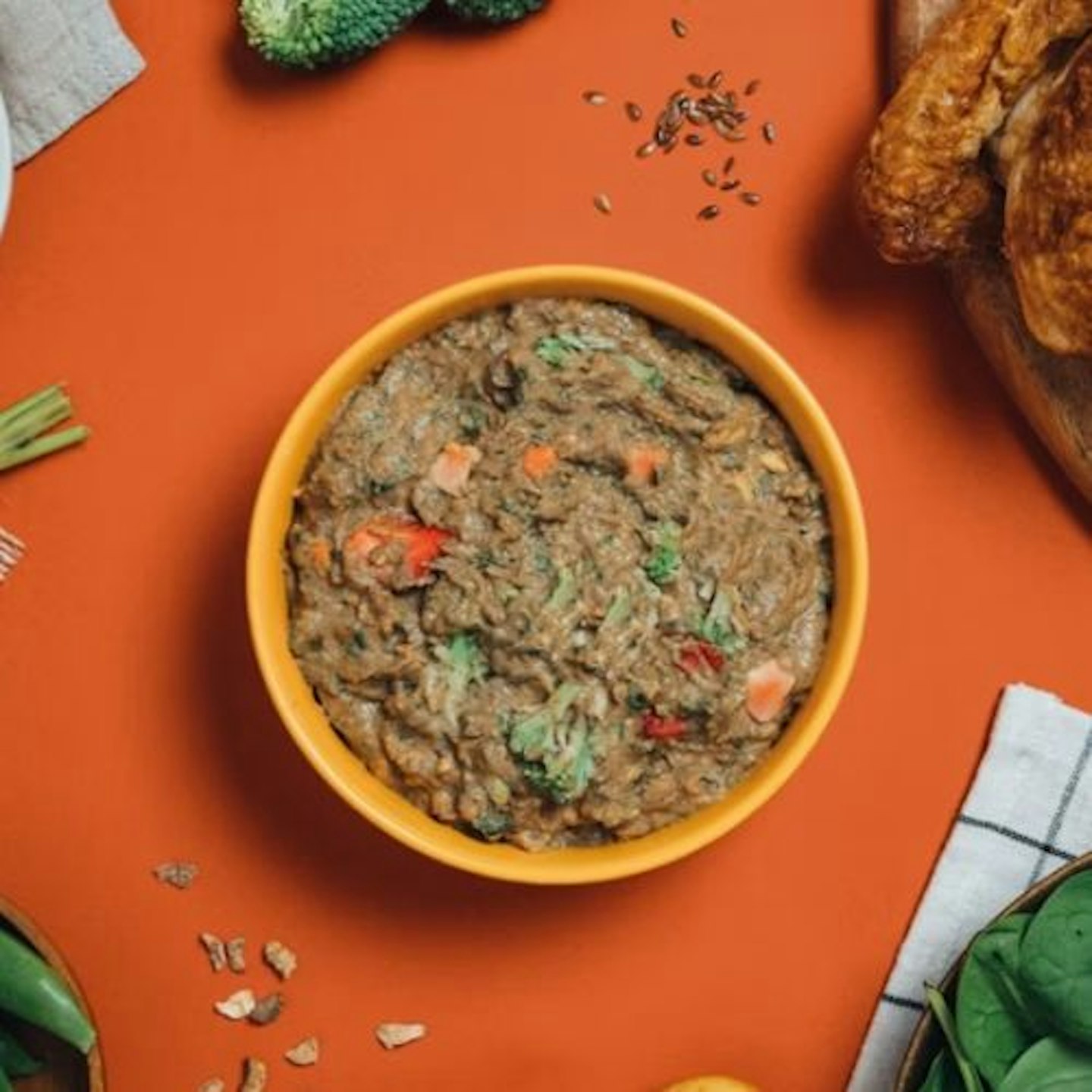 Pure Pet Food
Pure Pet Foodwww.purepetfood.com
To make being consistent about portion size a bit easier, Pure Pet Food does the calculations and provides perfectly tailored meals based on your dog's needs. Pure Pet Food is made from natural ingredients that are wholesome sources of slow-release energy and fibre to limit sugar spikes in diabetic dogs. It comes in an easy-to-store dehydrated format that is reconstituted in just 10 seconds by adding water.
The key features of Pure Pet Food's tailored recipes for diabetic dogs are complex carbohydrates, low-GI foods, and low-fat. If you provide Pure Pet Food with age, weight, and health information about your dog, they will create a tailored menu of complete and balanced meals. It's a subscription service with free delivery.
Customer testimonials praise Pure Pet Food for improving their dogs' vitality and energy levels. It's been effective in minimising digestive issues in dogs with sensitive stomachs and it improved the health of a dog with pancreatitis. The pricing will be based on your dog's individual needs, size and age. A reviewer commented that they found it slightly more expensive than standard commercial dog food, but the health and wellbeing benefits outweigh the cost.
Pros
- Made with wholesome, low-GI ingredients
- A tailored diet that is based on your dog's needs
- Complex carbs for steady energy release
- Low fat to maintain a slim body condition and keep the pancreas healthy
Cons
- Price will be based on your dog's individual needs
| Ingredients: | (Example) Chicken (53%), Potato, Dried Egg, Peas, Chicken Stock, Carrot, Linseed, Broccoli, Spinach (0.5%), Minerals, Omega 3 (from algae 0.3%), Strawberries (0.2%), Chicory Extract (0.1%), Glucosamine (0.05%), Chondroitin (0.05%), Beta Carotene (0.003%) |
How we chose the best dog food for diabetic dogs
All of these dog foods for diabetic dogs have been hand-selected by our team of Take A Break Pets shopping experts. We carefully considered the nutrition, quality and value in our selection of the best. Our team has spent hours investigating and researching dog foods for diabetic dogs to make it easier for you to find the very best, and we'd never recommend a product we don't believe in.
With pets big and small on our team, where possible we'll share the best products that have been tried and tested by our own furry friends who have given their paw of approval. And, with help from veterinary experts, we share their knowledge to ensure everything we choose is paw-fect for your pet.
How is diabetes in dogs treated?
Diabetes in dogs cannot be cured, but it can be managed. The aim is to get a dog's blood sugar level into a normal range and maintain it. This is done by insulin injections, a controlled diet and exercise. Instead of food treats, give attention and play as rewards. The PDSA have a comprehensive guide to diabetes in dogs.
It means a lifelong commitment to a routine of a strict diet, exercise and insulin injections at the same time every day. A dog with well-managed diabetes can live just as long as a dog without the condition. You must give your dog insulin injections twice daily with their food. You can't control diabetes in dogs without medication.
Diabetic dogs need to be fed the same amount of food at the same time every day, twice daily, 12 hours apart. Weigh out your dog's food so you know exactly how much you're giving them. Refrain from giving snacks or treats between meals, and be careful of leaving your leftovers in reachable areas where they could be snaffled.
The aim is to be able to anticipate how high their blood sugar level is going to rise after a meal, and that the right amount of insulin is being given to bring their blood sugar level back down. The risk is that if a dog eats too much, their blood sugar level will go too high. If they eat less than usual, their blood sugar level may go dangerously low and could result in hypoglycaemia (or a hypo), which is an emergency situation.
Exercise lowers blood sugar levels. Walks need to be kept the same duration each day, to maintain blood sugar levels. This keeps a balance between how much they are being fed, their level of activity and how much insulin to inject. This will keep their blood sugar level at a safe level. If you want to increase or decrease their amount of exercise do so gradually.
Your dog will need regular vet check-ups, and your vet will guide you on how to inject your dog and how much insulin to give. The injection is usually at the back of the neck, just under the skin.
Ask the expert FAQs<br><a href="https://burnspet.co.uk/team/laura-crotch-harvey/?" target="_blank" rel="noreferrer noopener nofollow">Laura Crotch-Harvey</a>, Nutrition Manager, Burns Pet Nutrition, answers some key questions about dogs and diabetes.
How do I know if my dog has diabetes?
"The most common symptoms of diabetes in dogs are excessive drinking and urination. Some dogs may also experience increased appetite, weight loss and lethargy. Just like in humans, overweight or obese dogs are at a higher risk of developing diabetes. As well as this, certain breeds, such as Cocker Spaniels, Labrador Retrievers, and Golden Retrievers, are also more prone to diabetes. Dogs typically develop diabetes at a middle or older age.
"If you have any concerns about your dog, you should take them to the vet for tests on their blood and urine to diagnose diabetes."
What is the ideal balance of macronutrients (proteins, fats and carbohydrates) for my diabetic dog?
"There are no specific protein, fat, and carbohydrate levels recommended for dogs with diabetes. It's important to consider your individual dog's needs. For example, an overweight dog with diabetes may have different dietary requirements than an underweight dog with diabetes and this will need discussing further with your vet.
"The diet doesn't necessarily need to be high in protein, but feeding high-quality protein is important to support muscle maintenance. Higher protein diets may also be higher in fat, so it's important to be mindful of this.
"In general, a low level of fat (12% or under) will be suitable for most dogs with diabetes, and this is especially important for overweight dogs.
"Fibre is included as part of the carbohydrates, and a high-fibre diet is important for diabetes as it provides a steadier release of energy and helps avoid spikes in blood glucose."
Should I choose prescription dog food, or are there over-the-counter options that work just as well?
"You don’t need a prescription diet for a diabetic dog; many over-the-counter products will be suitable. For example, at Burns, we have the Burns Weight Control Chicken & Oats, which isn’t a prescription product but meets the criteria for a diabetic dog due to its low sugar content and high fibre, providing a steady release of energy.
"The guidelines for a dog with diabetes focus on the total sugar content in the food, which should be low to avoid blood sugar spikes after a meal. The sugar level should be less than 62g/kg of the food if the moisture level is 12%. It's important to consider the moisture level, as wet and dry pet foods can have different nutrient levels due to the varying amounts of water they contain. If the food is marketed as suitable for diabetes, the total sugar content should be labelled on the bag. If not, you can contact the company to ask the level or if they have any suitable options."
How can I incorporate fibre into my dog’s diet, and how much is recommended?
"A high-fibre diet is very beneficial for dogs with diabetes, and the best way to ensure this is by feeding them complete dog food that is also high in fibre. Feeding a high-fibre dog food rather than adding extras is preferable, as adding extra food can cause an increase in the dog's glucose levels.
"If your dog is having difficulty with the available diets, any additional food should be added under the supervision of a vet, as it may impact the required insulin levels. Oats are an excellent high-fibre ingredient with a low glycaemic index."
How frequently and in what portions should I feed my diabetic dog?
"Diabetic dogs should be fed at the same time every day to help you understand their blood glucose levels throughout the day. Ideally, they should be fed 12 hours apart if possible.
"The amount of food given will depend on the food you have chosen to feed and there will be a guideline on the packaging. Feeding amounts are normally based on the dog's weight, age, activity level and if they have been neutered. If the dog is overweight, remember to feed for their target weight and not their current weight. The feeding amounts given by the brand are normally recommended over the day and then split evenly between two meals. It should also be consistent (so no extra treats on a weekend!)."
What treats can I feed to a diabetic dog?
"Try to keep treats to a minimum as anything extra given can cause blood glucose levels to rise. Any treats given should also be given at the same time every day. Look for ones that are high in fibre as well as low in fat and sugar, if possible. You can also use a couple of kibbles out of their main dog food (saved from their daily allowance) as treats, again if you give them the same time every day. Account for any treats given by reducing their daily feeding amounts slightly. Avoid treats like peanut butter or those including added sugar."
This article contains expert commentary from Laura Crotch-Harvey, Nutrition Manager, Burns Pet Nutrition.
Natalie Knowles is a Homes & Garden Product Writer for Take A Break Pets, specialising in all things cats and dogs. In her other life Natalie is a successful artist and illustrator.
